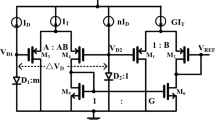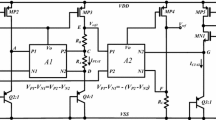Abstract
In this work a radiation-hardened bandgap voltage reference circuit is presented. The circuit is targeted at precision applications, where trimming can be used to achieve a temperature coefficient smaller than \(5~\mbox{ppm}/\mbox{K}\). Curvature compensation is employed and trimming of the temperature coefficient and the curvature is possible. In order to achieve good performance several techniques were combined. Radiation hardening techniques on layout level were used along with design techniques to improve the robustness against total ionizing dose (TID) and process variations. The radiation hardness requirements were set after preliminary irradiation tests. At the layout level optimized transistors were used while at the topology level, a radiation-hardened trimming scheme was employed to mitigate the impact of leakage currents. Chopping techniques were required to ensure good performance over the process and temperature variations. The bandgap was realized in a standard 180 nm CMOS process and circuit performance was verified using extensive simulations.
Zusammenfassung
In dieser Arbeit wird eine strahlungsgehärtete Bandgap-Spannungsreferenzschaltung vorgestellt. Die Schaltung ist auf Präzisionsanwendungen ausgelegt, wo Trimming verwendet werden kann, um einen Temperaturkoeffizienten von weniger als 5 ppm/K zu erreichen. Es wird eine Curvature-Kompensation verwendet, um Trimmen des Temperaturkoeffizienten und der Krümmung zu ermöglichen. Um eine gute Leistung zu erzielen, wurden verschiedene Techniken kombiniert. Strahlungshärtungstechniken auf Layout-Ebene wurden zusammen mit Designtechniken verwendet, um die Robustheit gegen die Gesamtdosis ionisierender Strahlung (Total Ionzing Dose, TID) und Prozessschwankungen zu verbessern. Die Anforderungen an die Strahlungshärte wurden nach ersten Bestrahlungstests festgelegt. Auf der Layout-Ebene wurden optimierte Transistoren verwendet, während auf der Topologie-Ebene ein strahlengehärtetes Trimmschema verwendet wurde, um die Auswirkungen von Leckströmen zu mindern. Chopping war erforderlich, um eine gute Performance trotz Prozess- und Temperaturschwankungen sicherzustellen. Die Bandgap-Referenz wurde in einem Standard-180-nm-CMOS-Prozess realisiert, und die Schaltungsleistung wurde mit umfangreichen Simulationen verifiziert.










Similar content being viewed by others
References
Banba, H., Shiga, H., Umezawa, A., Miyaba, T., Tanzawa, T., Atsumi, S., Sakui, K. (1999): A CMOS bandgap reference circuit with sub-1-V operation. IEEE J. Solid-State Circuits, 34(5), 670–674. https://doi.org/10.1109/4.760378.
Bezhenova, V., Michalowska-Forsyth, A. (2016): Total ionizing dose effects on MOS transistors fabricated in 0.18 μm CMOS technology. In 2016 Asia-Pacific international symposium on electromagnetic compatibility (APEMC) (Vol. 01, pp. 366–369). https://doi.org/10.1109/APEMC.2016.7522739.
Bezhenova, V., Michalowska-Forsyth, A. M. (2016): Effects of ionizing radiation on integrated circuits. E&I, Elektrotech. Inf.tech., 133(1), 39–42. https://doi.org/10.1007/s00502-015-0380-8.
Brokaw, A. (1974): A simple three-terminal IC bandgap reference. In 1974 IEEE international solid-state circuits conference. Digest of technical papers (Vol. XVII, pp. 188–189). https://doi.org/10.1109/ISSCC.1974.1155346.
Faccio, F., Cervelli, G. (2005): Radiation-induced edge effects in deep submicron CMOS transistors. IEEE Trans. Nucl. Sci., 52(6), 2413–2420. https://doi.org/10.1109/TNS.2005.860698.
Gaillardin, M., Goiffon, V., Girard, S., Martinez, M., Magnan, P., Paillet, P. (2011): Enhanced radiation-induced narrow channel effects in commercial 0.18 μm bulk technology. IEEE Trans. Nucl. Sci., 58(6), 2807–2815. https://doi.org/10.1109/TNS.2011.2170854.
Li, T., Yang, Y., Liu, T. (2016): Total ionizing dose response of 0.18 UM narrow channel I/O nMOSFETS. In 2016 13th IEEE international conference on solid-state and integrated circuit technology (ICSICT) (pp. 1209–1211). https://doi.org/10.1109/ICSICT.2016.7998694.
Malcovati, P., Maloberti, F., Fiocchi, C., Pruzzi, M. (2001): Curvature-compensated BiCMOS bandgap with 1-V supply voltage. IEEE J. Solid-State Circuits, 36(7), 1076–1081. https://doi.org/10.1109/4.933463.
Manghisoni, M., Ratti, L., Re, V., Speziali, V. (2002): Radiation hardness perspectives for the design of analog detector readout circuits in the 0.18-μm CMOS generation. IEEE Trans. Nucl. Sci., 49(6), 2902–2909. https://doi.org/10.1109/TNS.2002.805413.
Nowlin, N., Bailey, J., Turfler, B., Alexander, D. (2004): A total-dose hardening-by-design approach for high speed mixed-signal CMOS integrated circuits. Int. J. High Speed Electron. Syst., 14, 367–378.
Oldham, T., McLean, F. (2003): Total ionizing dose effects in MOS oxides and devices. IEEE Trans. Nucl. Sci., 50(3), 483–499. https://doi.org/10.1109/TNS.2003.812927.
Pan, D., Li, H., Wilamowski, B. (2003): A radiation-hard phase-locked loop. In 2003 IEEE international symposium on industrial electronics (Vol. 2, pp. 901–906). https://doi.org/10.1109/ISIE.2003.1267941.
Shetler, K. J., Atkinson, N. M., Holman, W. T., Kauppila, J. S., Loveless, T. D., Witulski, A. F., Bhuva, B. L., Zhang, E. X., Massengill, L. W. (2015): Radiation hardening of voltage references using chopper stabilization. IEEE Trans. Nucl. Sci., 62(6), 3064–3071. https://doi.org/10.1109/TNS.2015.2499171.
Song, B. S., Gray, P. R. (1983): A precision curvature-compensated CMOS bandgap reference. IEEE J. Solid-State Circuits, 18(6), 634–643. https://doi.org/10.1109/JSSC.1983.1052013.
Tsividis, Y. P. (1980): Accurate analysis of temperature effects in I/SUB c/V/SUB BE/ characteristics with application to bandgap reference sources. IEEE J. Solid-State Circuits, 15(6), 1076–1084. https://doi.org/10.1109/JSSC.1980.1051519.
Widlar, R. J. (1971): New developments in IC voltage regulators. IEEE J. Solid-State Circuits, 6(1), 2–7. https://doi.org/10.1109/JSSC.1971.1050151.
Author information
Authors and Affiliations
Corresponding author
Rights and permissions
About this article
Cite this article
Auer, M., Bezhenova, V. A radiation-hard curvature compensated bandgap voltage reference. Elektrotech. Inftech. 135, 3–9 (2018). https://doi.org/10.1007/s00502-018-0591-x
Received:
Accepted:
Published:
Issue Date:
DOI: https://doi.org/10.1007/s00502-018-0591-x
Keywords
- bandgap voltage reference
- chopping
- radiation hardness
- curvature compensation
- total ionizing dose
- leakage reduction




